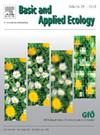实验性减少土地利用增加了草原无脊椎动物的丰度
IF 3.5
2区 环境科学与生态学
Q2 ECOLOGY
引用次数: 0
摘要
草原是多种多样的生态系统,日益受到土地集约利用的威胁。通过减少土地利用强度来恢复草地可以支持昆虫的丰富度和多样性,有助于阻止昆虫的减少。为了测试土地利用减少对无脊椎动物的影响,我们在德国三个地区的45个地点进行了一项实验(建立于2020年)。我们假设,减少土地利用会增加无脊椎动物的数量,在使用较少的草原上产生更大的影响。2021年5月和2023年5月,采用吸采法对无脊椎动物进行定量采样,其中2021个样本通过DNA元条形码进行鉴定。将土地利用减少到一次晚割,一年后无脊椎动物的数量增加了41%,三年后增加了99%。不同处理与对照间物种多样性无显著差异。土地利用减少对丰度的影响始终受到周围基质土地利用的影响,在刈割频率较低但施肥程度较高的草地上,正效应较大。尽管在恢复效应的程度上存在这些地方差异,但无脊椎动物丰度的持续增加表明,降低土地利用强度可以增加无脊椎动物的数量,对生态系统功能有潜在的好处。研究土地利用减少的结果如何随着时间的推移而发展是很重要的,因为土地利用减少在永久实施时可能会更成功。本文章由计算机程序翻译,如有差异,请以英文原文为准。
Experimental reduction of land use increases invertebrate abundance in grasslands
Grasslands are diverse ecosystems that are increasingly threatened by intensive land use. Restoring grasslands by reducing land-use intensity may support insect abundance and diversity, helping to halt insect declines. To test for the effect of reduced land use on invertebrates, we studied an experiment (established 2020) at 45 sites across three regions of Germany. We hypothesized that reduced land use increases invertebrate abundance, with larger effects in less intensively used grasslands. Using suction sampling, invertebrates were quantitatively sampled in May 2021 and May 2023, with 2021 samples identified by DNA meta-barcoding. Reducing land use to a single late mowing increased invertebrate abundance by 41 % after one year and 99 % after three years. However, species diversity did not differ between treatments and controls. The effect of land-use reduction on abundance was consistently influenced by land use in the surrounding matrix, with larger positive effect sizes at grasslands with lower mowing frequency but higher fertilization. In spite of these local differences in the magnitude of restoration effects, the consistent increase in invertebrate abundance suggests that reducing land-use intensity can enhance invertebrate populations with potential benefits for ecosystem functions. It will be important to study how outcomes of land-use reduction develop over time, as land-use reduction is likely more successful when implemented permanently.
求助全文
通过发布文献求助,成功后即可免费获取论文全文。
去求助
来源期刊

Basic and Applied Ecology
环境科学-生态学
CiteScore
6.90
自引率
5.30%
发文量
103
审稿时长
10.6 weeks
期刊介绍:
Basic and Applied Ecology provides a forum in which significant advances and ideas can be rapidly communicated to a wide audience. Basic and Applied Ecology publishes original contributions, perspectives and reviews from all areas of basic and applied ecology. Ecologists from all countries are invited to publish ecological research of international interest in its pages. There is no bias with regard to taxon or geographical area.
 求助内容:
求助内容: 应助结果提醒方式:
应助结果提醒方式:


